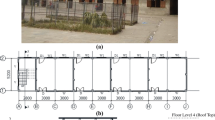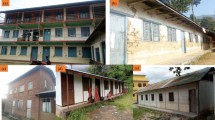Abstract
The majority of structures in seismic-prone areas worldwide are structures that have been designed either without seismic design considerations, or using codes of practice that are seriously inadequate in the light of current seismic design principles. In Cyprus, after a series of earthquakes that occurred between 1995 and 1999, it was decided to carry out an unprecedented internationally seismic retrofitting of all school buildings, taking into account the sensitivity of the society towards these structures. In this paper representative school buildings are analysed in both their pristine condition and after applying retrofitting schemes typical of those implemented in the aforementioned large-scale strengthening programme. Non-linear analysis is conducted on calibrated analytical models of the selected buildings and fragility curves are derived for typical reinforced concrete and unreinforced masonry structures. These curves are then used to carry out a feasibility study, including both benefit-cost and life-cycle analysis, and evaluate the effectiveness of the strengthening programme.

























Similar content being viewed by others
References
Anastasiades A, Pitilakis K, Apessou M, Apostolides P, Kallioglou P, Tika T, Michaelides P, Petrides G (2006) Site Specific Response Analyses in Lemessos Urban Area. In: Proceedings 5th Hellenic Conference on Geotechnical and Geoenvironmental Engineering, Technical Chamber of Greece (in Greek)
ASCE/SEI (2007) Seismic rehabilitation of existing buildings—ASCE Standard 41-06. American Society of Civil Engineers, Reston, Virginia
Ayyub B, McCuen R (1995) Chapter 4—Simulation-based reliability methods. In: Sundararajan CR (ed) Probabilistic structural mechanics handbook-theory and industrial applications. Chapman & Hall, London, pp 53–69
Beyer K, Mangalathu S (2013) Review of strength models for masonry spandrels. Bull Earthq Eng 11(2):521–542
Cattari S, Lagomarsino S (2008) A strength criterion for the flexural behaviour of spandrels in un-reinforced masonry walls. In: 14th World Conference on Earthquake Engineering, Beijing, China, Paper No. 05-04-0041
CEN (2004a) Eurocode 2: design of concrete structures. Part 1: general rules and rules for buildings (EN 1992-1-1). CEN, Brussels
CEN (2004b) Eurocode 8: Design provisions of structures for earthquake resistance. Part 1: general rules, seismic actions and rules for buildings (EN1998-1). CEN, Brussels
CEN (2005) Eurocode 8: Design provisions of structures for earthquake resistance. Part 3: assessment and retrofitting of buildings (EN1998-3). CEN, Brussels
Chrysostomou CZ, Kyriakides N, Kappos AJ, Kouris LA, Papanikolaou V, Georgiou E, Millis M (2013) Seismic retrofitting and health monitoring of school buildings of Cyprus. Open Constr Build Technol J 7:208–220
Coburn A, Spence R (2002) Earthquake protection, 2nd edn. Wiley, Chichester, England
CSI [Computers & Structures Inc.] (2011) SAP2000—Version 15.0.1: linear and non linear static and dynamic analysis and design of three-dimensional structures. CSI, Berkeley, California
Ellingwood BR, Wen YK (2005) Risk–benefit-based design decisions for low-probability/high consequence earthquake events in Mid-America. Prog Struct Eng Mater 7:56–70
FEMA (1992) A benefit cost: model for the seismic rehabilitation of structures, vol 1, 2
FEMA-NIBS (2003) Multi-hazard loss estimation methodology: earthquake model: HAZUS®MH Technical Manual, Washington DC
Frangopol DM, Kong JS, Gharaibeh ES (2001) Reliability-based life-cycle management of highway bridges. J Comput Civ Eng 15(1):27–34
Japan Ministry of Education, Culture, Sports, Science and Technology (2006) Seismic retrofitting quick reference: school facilities that withstand earthquakes, Tokyo
Kappos AJ, Dimitrakopoulos EG (2008) Feasibility of pre-earthquake strengthening of buildings based on cost-benefit and life-cycle cost analysis, with the aid of fragility curves. Nat Hazards 45(1):33–54
Kappos AJ, Pitilakis K, Stylianidis K, Morfidis K, Asimakopoulos D (1995) Cost-benefit analysis for the seismic rehabilitation of buildings based on a hybrid method of vulnerability assessment. In: 3rd International Conference on Seismic Zonation, vol. I, Nice, France, 406–413
Kappos AJ, Penelis GG, Drakopoulos C (2002) Evaluation of simplified models for the analysis of unreinforced masonry (URM) buildings. J Struct Eng ASCE 128(7):890–897
Kappos AJ, Panagopoulos G, Panagiotopoulos C, Penelis G (2006) A hybrid method for the vulnerability assessment of R/C and URM buildings. Bull Earthq Eng 4(4):391–413
Koliopoulos PK, Margaris BN, Klimis NS (1998) Duration and energy characteristics of Greek strong motion records. J Earthq Eng 2(3):391–417
Kyriakides N, Ahmad S, Pilakoutas K, Neocleous K, Chrysostomou C (2014) A probabilistic analytical seismic vulnerability assessment framework for low strength structures of developing countries. Earthq Struct 6(6):665–687. doi:10.12989/eas.2014.6.6.665
Lagomarsino S, Cattari S (2015) PERPETUATE guidelines for seismic performance-based assessment of cultural heritage masonry structures. Bull Earthq Eng 13(1):13–47
Liu M, Burns SA, Wen YK (2003) Optimal seismic design of steel frame buildings based on life-cycle cost considerations. Earthq Eng Struct Dyn 32:1313–1332
McKay M, Conover W, Beckman R (1979) A comparison of three methods for selecting values of input variables in the analysis of output from a computer code. Technometrics 21:239–245
OECD (2004) Keeping schools safe in earthquakes; a publication of the OECD Programme on Educational Building (PEB)
Papaioannou CA (2004) Seismic hazard scenarios: probabilistic assessment of the seismic hazard report for WP 02 of the project SRM-LIFE (scientist in charge K. Pitilakis), ITSAK, Thessaloniki (in Greek)
Papazachos BC, Savaidis AA, Papaioannou CA, Papazachos CB (1999) The S. Balkan Bank of shallow and intermediate depth earthquake microseismic data, XXII Gen. Ass. Of the IUGG, Birmingham, UK, July 1999 (abstracts volume)
Penelis GG (2006) An efficient approach for pushover analysis of unreinforced masonry (URM) structures. J Earthq Eng 10(3):359–379
Sextos AG, Pitilakis KD, Kappos AJ (2003) Inelastic dynamic analysis of R/C bridges accounting for spatial variability of ground motion, site effects and soil-structure interaction phenomena. Part 1: methodology and analytical tools. Earthq Eng Struct Dyn 32(4):607–627
Smyth AW, Altay GI, Deodatis G, Erdik M, Franco G, Gulkan P, Kunreuther H, Lus H, Mete E, Seeber N, Yuzugullu O (2004) Probabilistic benefit/cost analysis for earthquake damage mitigation: evaluating measures for apartment houses in Turkey. Earthq Spectra 20(1):171–203
Ventura CE, Finn WDL, Bebamzadeh A, Pina F, Taylor GW (2012) Seismic retrofit of school buildings in British Columbia, Canada. In: Proceedings of 12th World Conference on Earthquake Engineering, Lisbon, paper no. 5496
Wen YK, Kang YJ (2001a) Minimum building life-cycle cost design criteria. I: methodology. J Struct Eng ASCE 127(3):330–337
Wen YK, Kang YJ (2001b) Minimum building life-cycle cost design criteria. II: applications. J Struct Eng 127(3):338–346
Acknowledgments
This project ΑΕΙFΟRΙΑ/ΑSΤΙ/0609(ΒΙΕ)/06 is funded under DESMI 2009–10 of the Research Promotion Foundation of Cyprus and by the Cyprus Government and the European Regional Development Fund. The authors would like to acknowledge also the contribution of Mrs E. Georgiou and O. Vassiliou from the Technical Services of the Ministry of Education and Culture of Cyprus and Ms. Elpida Georgiou in the collection of data for the school retrofitting programme, and of Dr L. Kouris (then Ph.D. candidate at the AUTh) in the early part of the analysis of the masonry building.
Author information
Authors and Affiliations
Corresponding author
Rights and permissions
About this article
Cite this article
Chrysostomou, C.Z., Kyriakides, N., Papanikolaou, V.K. et al. Vulnerability assessment and feasibility analysis of seismic strengthening of school buildings. Bull Earthquake Eng 13, 3809–3840 (2015). https://doi.org/10.1007/s10518-015-9791-5
Received:
Accepted:
Published:
Issue Date:
DOI: https://doi.org/10.1007/s10518-015-9791-5




